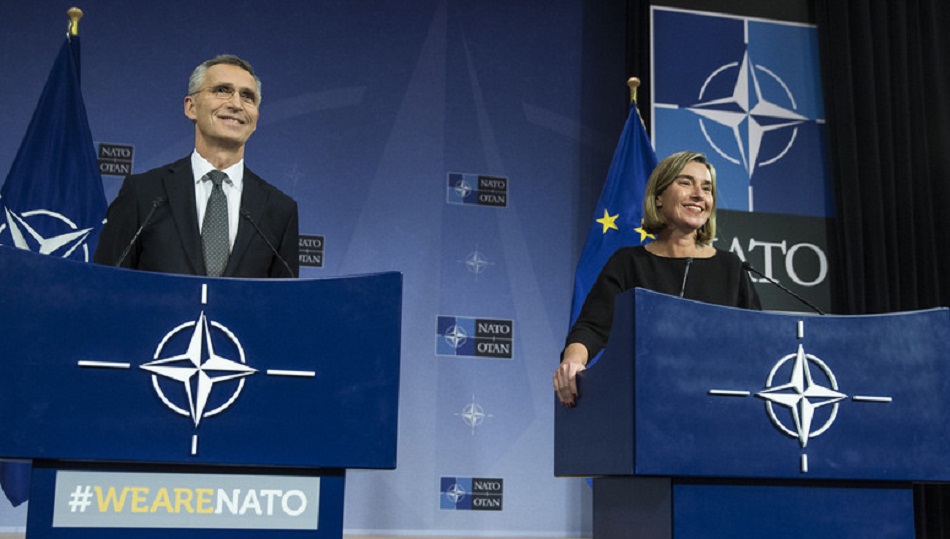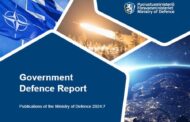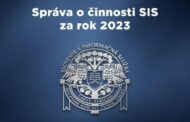Joint press conference
by NATO Secretary General Jens Stoltenberg and EU High Representative/Vice President Federica Mogherini following the meeting of the North Atlantic Council at the level of NATO Foreign Ministers
_____________________________________________________________________________________________________________________________________
Good evening.
We have just finished a meeting with the NATO Foreign Ministers where we were joined by High Representative/Vice President Federica Mogherini and also the Foreign Ministers of Sweden and Finland.
And I will start by thanking Federica for being with us and for joining us in addressing an issue which is of great importance both for NATO and for the EU. And that is European defence and the cooperation between NATO and the EU. And I would also like to thank you, Federica, for your strong personal commitment, for the hard work you’ve been putting into this over a long period of time which has resulted in real progress.
And this is important for both NATO and the EU because we know that 90% or actually more than 90% of the people in the EU are citizens of a NATO country. We face the same security environment, we face the same challenges. And therefore we have to respond together based on our common values.
And back in July 2016, I signed a joint declaration with the Presidents Juncker and Tusk and after that Federica and I followed up with 42 concrete measures and we have been working on the implementation of these measures since then, and we have really made progress.
For instance on countering hybrid threats.
Federica and I inaugurated the Centre of Excellence in Helsinki a few weeks ago.
On cyber, NATO and the European Union can now exchange warnings about cyber-attacks and malware in real time.
And just last week, the EU participated in NATO’s Cyber Coalition exercise, one of the biggest in the world, yet another example of how we are strengthening our concrete cooperation.
In the maritime domain, NATO’s maritime operation Sea Guardian provides critical support to the EU’s Operation Sophia.
And there are many other examples but now today, tonight, we agreed on additional measures. So the task for Federica and me, for our staff for the European Union, for NATO, is to make sure that we are fully implementing those measures. And let me just mention three new areas where we have agreed to strengthen our cooperation.
First – moving our forces and equipment quickly is vital for our security. This means we need procedures for rapid border crossing.
As well as sufficient transport assets. And robust infrastructure meaning roads, railways, ports and airports. So it’s obvious that this is an area where we need strong and very detailed and concrete cooperation between NATO and EU when it comes to military mobility. And our aim is to make military mobility a new flagship for the NATO-EU cooperation.
Second – in the fight against terrorism, we decided to strengthen the exchange of information between us. And to coordinate our counter-terrorism support for partner countries.
And third – we will do more together to promote women’s role in peace and security.
In our own organisations, and in our military operations. It’s not just the right thing to do, but it’s also the smart thing to do.
So we are taking cooperation between NATO and the EU to a new level. This is more important than ever, as the EU looks to strengthen European defence, through Permanent Structured Cooperation and the European Defence Fund.
These steps can lead to increased defence spending, more modern capabilities, and fairer transatlantic burden sharing.
To ensure these efforts complement what NATO does, we must keep in mind some key principles: EU and NATO capability development must be coherent. Because we cannot present conflicting requirements and priorities to our nations. Forces and capabilities must be available for both EU and NATO. And non-EU Allies need to be involved to the fullest extent possible. Because they play an important role in European security.
NATO has ensured European peace and security for almost seventy years. And remains the cornerstone of our collective defence.
At the same time, we are determined to further strengthen our cooperation with the EU.
So for me it’s really a great pleasure to once again meet with Federica, to discuss and to agree and decide on how we take this cooperation further and then to know that we will work together also making sure that the we are implementing those measures. So welcome again, and please, you have the floor.
MODERATOR: We have time for a few questions: Wall Street Journal.
Q (Wall Street Journal): Mr. Stoltenberg, I wondered if you would talk a little bit more about the military mobility and what you want to see out of the EU. Is this about creating standards for roads and bridges so that they can take an American tank, say? How can the EU sort of speed up this sort of movement? And for the High Representative, did you hear what you wanted to hear today from Mr. Tillerson on the Iran nuclear deal? Do you take his comments about fully enforcing the deal as in some way a signal that the US will stand by it?
JENS STOLTENBERG (Secretary General of NATO): Military mobility is about the need to be able to move forces quickly across Europe, so that’s partly about addressing some of the legal hurdles, some of the bureaucratic hurdles we will face when we for instance cross borders but also other regulations, and that’s partly nations and partly the EU as an institution that has to address those legal hurdles. Then, military mobility is about infrastructure, meaning that we need the roads, the bridges, the towns, and harbours, and airports which are able then to receive and then frame or to facilitate the transportation of heavy equipment and supplies.
During the Cold War NATO developed many standards addressing these challenges, but we have to remember that very big parts of Europe were not members of NATO, they were members of the Warsaw Pact, so of course these standards never applied for that part of Europe. And second, NATO countries have not been so very focused on this since the end of the Cold War, so now we have to again look into can we make sure that at least we have some transport corridors where we are able to transport heavy equipment, including equipment from outside Europe, from the United States, Canada, and other non-EU member states.
So this is also about standards and making sure that we have the infrastructure in place that can receive and transport the equipment and the forces we need. And it’s also about making sure that we have the transportation assets. During the Cold War, many of these assets were state-owned, now much of it has been privatized, for instance railroad companies, so therefore we need to engage with the private sector, make sure that we have these assets available if needed: ships, trucks, planes, and other means of transportation.
So there is a wide range of issues that has to be addressed. We have started to work, our staffs have started to address them to identify the gaps, to compare information, and it will be a combination of nations, EU and NATO that has to develop and to solve the challenge we face when it comes to military mobility.
FEDERICA MOGHERINI (Vice-President of the European Commission and High Representative of the European Union for Foreign Affairs and Security Policy): My answer is very short: yes.
MODERATOR: Okay.
FEDERICA MOGHERINI : Then we’ll see the follow-up.
MODERATOR: NPR Deutsche Welle, fourth row, lady in the fourth row.
TERI SCHULTZ (NPR and Deutsche Welle): Hi, thank you, Teri Schultz with NPR and Deutsche Welle. For both of you please, what did you make of the German Foreign minister’s comments coming into this meeting saying that US leadership is crumbling, that the US seems to see Europe as a competitor rather than a partner sometimes and is pursuing policies that might be hurting its allies rather than helping? I’m interested in both of your reactions. Thank you.
JENS STOLTENBERG : Well, Minister Sigmar Gabriel also stated very clearly that he doesn’t see European defence as an alternative to NATO. He’s strongly in favour of a strong transatlantic bond, and that’s exactly the message from Federica and from me. This is not about creating something which is going to compete with NATO but this is something that is going to be complementary and to strengthen NATO.
Then I think we have to remember that NATO is an alliance of 29 different nations, democracies, and there are very often different views on different issues, and they are discussed among allies, among friends, and sometimes we see that there are disagreements also about issues related to foreign policy, environment, trade, and many other issues. But the strength of NATO is that we have been able again and again to prove that despite of these differences we are always able to agree on the core task of NATO, and that is that we are there to protect each other, that our collective defence is the best way to ensure peace, and Article 5, the collective defence clause, that an attack on one ally will trigger a response from the whole alliance. And I know that Sigmar Gabriel is very clear on this, as is all other allies.
Let me also add that we see that the United States is actually increasing their presence in Europe. We have more troops, we have more equipment, we have more US exercises now. After years of decline after the Cold War the US has started to increase their presence and they’re also increasing funding for the European Deterrence Initiative to close to US $5 billion.
So it is more funding from the United States, there are more troops, more equipment, so I think that just underlines that the United States is committed to the transatlantic bond, the United States is not leaving Europe, actually it’s coming back to Europe, also with Canada, and I welcome the leadership of the United States in the alliance, and I met with Secretary Tillerson and he reiterated his ironclad commitment to the alliance – the U.S. ironclad commitment to the alliance. So we are an alliance of 29 democracies, sometimes there are different views, but we agree on the core task that we are there to protect each other.
FEDERICA MOGHERINI : On the European Union side obviously we are in a different position because we are a political union of 28 also democracies and we have with the United States not a relationship of alliance but of partnership and friendship. And this is a common basis that unites us not only for our history but also for the future perspectives of trying to handle together some of the challenges the world is facing and trying to get some of the opportunities the world is offering. And this is still the solid basis of the transatlantic friendship and partnership between the European Union and the United States.
I particularly appreciated the fact that today Secretary Tillerson, before coming here, spent three hours, three good hours I would say, first in a bilateral meeting with me, and then with all the 28 foreign ministers of the member states of the European Union, paying an official visit to the European Union institutions, as President Trump and Vice President Pence already did earlier this year. And this is clearly a sign of recognition of our partnership, not only in the framework of NATO as a military alliance, this is not my business, as European obviously I have a specific interest in that working well, but of the US-EU as such partnership.
We had an excellent meeting today. There are many issues on which we work together and if we were not working together the security situation in large parts of the world would be much worse than the one we’re facing today. If you think of DPRK, if you think of Afghanistan, if you think of Syria, and I could continue, Libya, some crisis in Africa, and again I could continue a long list, counterterrorism, anti-Daesh, Ukraine, and again the list is long, there are many files on which our cooperation is vital and is achieving results.
There are other areas on which the European Union and the United States have different positions on foreign policy, and we’re very open and frank about that, very candid, and today also around the table on the other side of Brussels in the EU institutions, we had a very frank discussion about this, as friends do. Recognizing the different arguments, recognizing the different positions is what allows us to understand each other’s position, respect them, but also trying to avoid mistakes or trying to find a way to cooperate even when positions are different. I don’t think you want a list of issues on which our positions are different. You know them.
One was the nuclear deal with Iran where the European Union and its member states made very clear the fact that for us it’s a strategic priority that matters to our security, a nuclear deal that is working and that has been certified nine times by the IAEA as working, needs to be preserved especially as we’re facing another nuclear proliferation crisis further east, but also for the overall credibility of international negotiations and agreements, and the message was heard I think loud and clear in Washington, and I think that today we are in a better place when it comes to the commitment to stay compliant with the agreement and work together to keep Iran compliant with the agreement, which is our major common work to be done.
We have a difference of views when it comes to multilateralism and in particular the UN system. We are as the European Union the strongest supporters of the UN system and a rules-based global order that includes investment in UN peacekeeping, something we share by the way with another transatlantic partner that is also very much a friend, Canada, but also for us this involves trade and the upcoming WTO ministerial next week in Argentina will also be a test for the way in which we see international relations.
This was evident on the climate change agreement. Well, I was personally saddened, and this was also shared today by other European Union member states ministers, that the United States decided to leave the Global Compact of the United Nations on Migration and Refugees, we believe and we invest in multilateral mechanisms and systems and we wish to do this more and more with the United States. This is the way we take to foreign policy and security policy as well.
There’s another issue we mentioned briefly today, even with the press, of difference of views maybe, let’s see, we in Europe believe that the only perspective for peace and security for Israel and Palestine is the two-state solution, not of idealism but out of experience. We believe this is the only realistic option for both and the for the region, and we are in good company in believing that, and namely the Arab Peace Initiative that we still believe is a useful framework for finding a solution to the crisis, to the conflict, is still a very useful framework, as we believe that any move that could derail the possibility of relaunching talks, for instance moves around Jerusalem, would be detrimental in immediate terms and in the perspective of reopening a diplomatic process in the Middle East.
So we have differences but we have more things on which we work in a cooperative manner, and even on the points on which we have differences we put as a priority the candid, open, frank conversation, not frank and constructive as journalists mean it, but as we mean it, we human beings mean it, meaning positive and looking for common ground and common action to be taken, very respectful and always in a sense of friendship.
MODERATOR: Okay. Pobjeda, from Montenegro.
Q (Pobjeda): Twenty-three of 28 EU member states have recently agreed to sign an agreement about a joint military investment, so did you discuss about that today, and does that represent an alternative to NATO in Europe?
JENS STOLTENBERG : No, but I think Federica can say more about the EU.
FEDERICA MOGHERINI : No. I can say the same. No. You mean the military command?
Q: Yes.
FEDERICA MOGHERINI : Yeah, no, not at all. That was one of the big taboos. It’s simply the fact that the European Union has already ongoing military and civilian missions and operations, we have 16 of them, only in Africa we have more than 10,000 men and women serving under EU flag, and it only makes sense from a military point of view, by the way also from a civilian point of view, to have one command structure. And here in NATO this is perfectly understood, it’s a matter of making the most out of the already existing missions and operations we have, it’s a matter of making them work better with a streamlined chain of command, and this is not at all and will never be a way of creating of shape kind of structure.
It is clear, crystal clear, that we’re not looking at duplications, we’re not looking at ways to turn the European Union into a military alliance, but we are looking at mak e the most out of the instruments we have, including some of our defence instruments. But there’s no competition, only complementarity, and no ambition to turn the European Union into a military alliance. We stay a political union, with some defence instruments that we’re trying to use at their best.
MODERATOR: I’m afraid that’s all we have time for because the ministers‘ dinner will start very soon, so thank you very much.
FEDERICA MOGHERINI : Thank you.
JENS STOLTENBERG : Thank you.
* * * * *
Zdroj: https://www.nato.int/cps/en/natohq/opinions_149339.htm?selectedLocale=en







